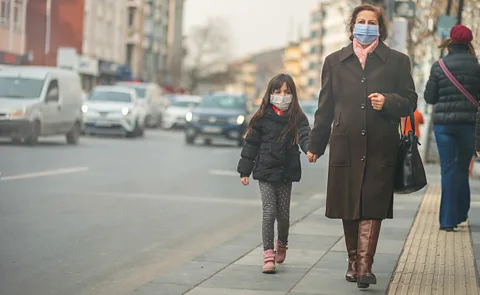
New research shows that girls in the United States are getting their first periods earlier. Exposure to toxic air is partly to blame.
From the time girls experience their first period, what scientists call menarcheal age, to the start of breast development, these seminal changes marking the start of adolescence appear to occur progressively earlier.
The same trend has also been observed all over the world. South Korean scientists have described with some alarm how the number of girls showing signs of early puberty – whether breast development or menstruation before the age of eight – increased 16-fold between 2008 and 2020.
“We also find that this decline in puberty age is even more pronounced in lower socioeconomic status groups and in ethnic minority groups,” says Audrey Gaskins, an associate professor at Emory University in Atlanta, in the USA. “This has important implications for long-term health.”
Researchers like Gaskins are primarily concerned that starting puberty earlier could trigger a cascade of events that would have far-reaching consequences later in adulthood. Emerging data suggests that this could not only shorten the fertile window, particularly if these women enter menopause earlier, but also shorten their lives. Early puberty has repeatedly been linked to a higher risk of diseases ranging from breast and ovarian cancersmetabolic syndromes such as obesity and type 2 diabetesAnd heart disease.
Scientists are still trying to understand why this is the case, but Brenda Eskenazi, a professor of public health at the University of California, Berkeley, says one theory suggests that if the body’s cells are exposed to circulating levels of sex hormones such as estrogen for a longer period of time, this can increase the risk of developing tumors because these hormones stimulate cell growth.
“There are some theories that a longer period of exposure to hormones increases the risk of reproductive cancers,” she says.

Then there are the possible social consequences. Eskenazi points out that girls who enter puberty earlier are also more likely to become sexually active earlier. “There is a scary situation in the United States when we have the trend towards abortion becoming illegal and contraception is not available,” she says. “It’s going to lead to more unwanted teenage pregnancies, so the confluence of factors is very scary.”
But why is the child’s development accelerated in this way?
From obesity to air pollution
The onset of puberty is dictated by two large communication networks in the body, called the hypothalamic-pituitary-adrenal (HPA) and hypothalamic-pituitary-gonadal (HPG) axes. They connect a region of the brain called the hypothalamus that regulates various essential bodily functions, from hunger to temperature control, with different hormone-secreting glands.
Gaskins says that until 10 or 20 years ago, scientists thought the only cause of premature puberty was childhood obesity, with proteins produced by fat cells called adipokines playing a role in stimulating the HPA and HPG axes. “It’s only recently that people have said, ‘Oh, that doesn’t explain everything, and there must be other factors involved,'” she says.
Instead, a number of studies over the past three years have pointed to another, more surprising cause: air pollution.
Much of this research was carried out by scientists in South Korea, with Seoul, Busan and Incheon ranking among the 100 most polluted cities in the world according to the IQAir Index. A recently published review from Ewha Women’s University in Seoul, identified a repeated relationship between exposure to various pollutants and early onset of puberty.
Fine particulate matter (PM), particles far too small to be visible, but which are released into the air from sources ranging from construction sites to forest fires, power plants, vehicle engines and even dusty, unpaved roads, are perhaps even more of a concern. In October 2023, Gaskins and colleagues found that American girls exposed to high amounts of PM2.5 – defined as particles with a diameter less than 2.5 μm – and PM10, both in the womb their mother and during childhood, are more likely to get their first period at an earlier age.
“PM2.5 particles can enter the bloodstream quite easily,” says Gaskins. “You inhale them into your lungs, and they’re not filtered like some of the larger particles would be, and they can then reach different organs. We’ve seen some PM2.5 particles accumulate in the placenta, fetal tissues, the ovaries, they can go anywhere.”

Studies using mixtures of particles found in indoor air samples, showed that chemicals in these fine particles are able to interact with receptors for various hormones involved in development – including androgens and estrogens. This can potentially start a chain reaction leading to the onset of puberty.
“That was our main hypothesis, that girls who were more exposed to PM2.5 were also exposed to more chemicals that mimic estrogen or just disrupt that HPA axis and its regular signals, causing the body to enter into puberty,’” Gaskins said.
At the same time, many different factors are likely involved in premature puberty. Gaskins suggests that new evidence regarding PM2.5 and other pollutants is just one example of how harmful environmental chemicals can enter the body, stimulating wide-ranging hormonal changes. (Learn more about how unhealthy air changes your body and mind.)
“Pre-pubescent girls are an interesting group because they represent another major route of exposure to chemicals that disrupt hormonal processes. it’s through personal care products“, says Gaskins. “And there are many companies now that are actively targeting this demographic and marketing products to them.”
Overall, Eskenazi says there is still much we don’t know about the complex connection between our changing world and how these fluctuations affect child development, the role of factors such as microplastics and even climate change being very unknown.
“I think we’re still just at the tip of the iceberg,” she says. “We don’t know how a warmer climate affects the menstrual cycle, or even the role of social factors, in causing girls to grow earlier. But this trend is real and could be a multifactorial combination of environmental chemicals, obesity and psychosocial problems which combine to lower the age of menarche.
